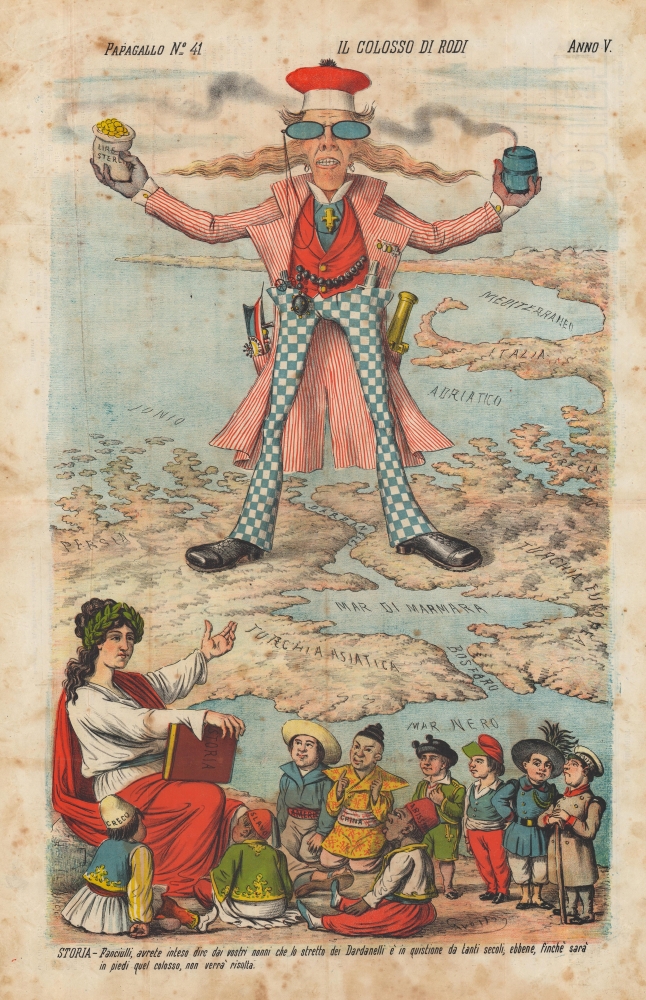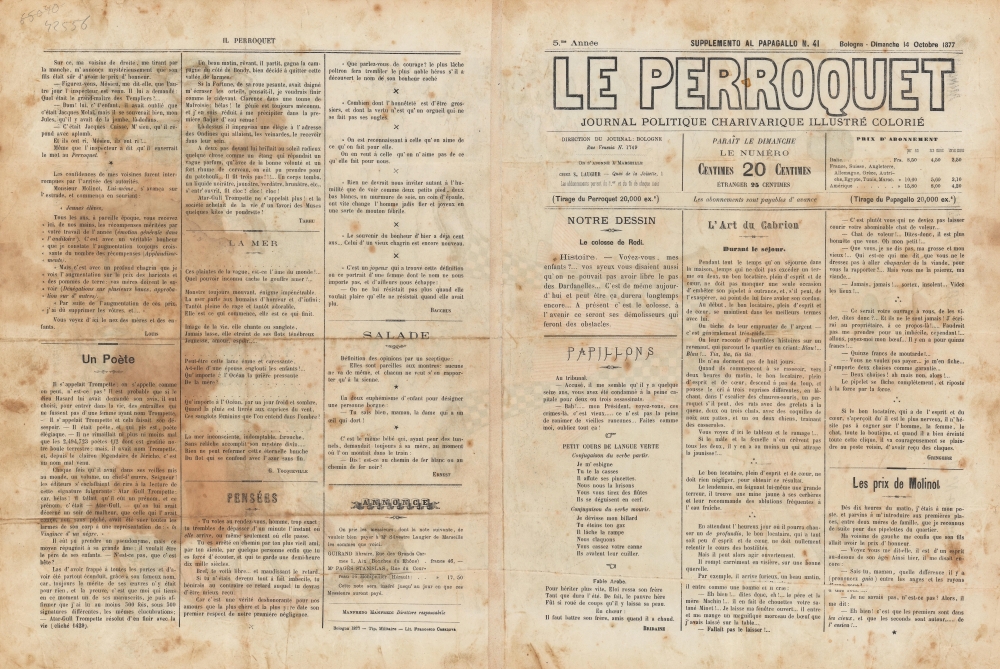1877 Grossi Allegorical Map of the Dardanelles w/ England as Colossus
ColossodiRodi-grossi-1877
Title
1877 (dated) 14 x 23 in (35.56 x 58.42 cm)
Description
A Closer Look
The British Empire is presented a mighty if insane colossus (John Bull) standing astride the Dardanelles facing the Sea of Marmara, the Bosporus, and the Black Sea. In one hand the sunglassed figure of John Bull holds a bag of Lire, in the other, a lit powder keg, representing wealth and violence. Despite his comic appearance, the figure is festooned with weapons, among them wealth (bag of gold) and grenades, and he bears a fleet in one pocket and a cannon in the other. At his feet, a teacher dressed in ancient Greek robes reveals the story of the Dardanelles to children of different peoples, including Greeks, Slavs, Americans, Chinese, Abyssinians, and various Europeans. A warning to the world against the duplicity of Russia, but also against Britain itself which, while here a savior, nonetheless expresses an 'unhinged' aspect.The Legend
Translated the legend reads:The colossus of Rhodes. History, do you see, my children? ... Your ancestors also told you that we could not have the freedom of the Dardanelles ... It is the same today and maybe it will last a long time ... Now it's the colossus, in the future it will be its demolisher who will make obstacles.This cartoon references an episode of the Russo-Turkish War (1877 - 1878). By the time of this piece's publication, the Ottomans had been soundly defeated by the Russians, but under pressure from Great Britain, Russia reluctantly accepted a truce. Despite the truce, Russian forces continued to move towards the Ottoman capital at Constantinople. The British fleet maneuvered to protect Istanbul and the Dardanelles and deter the Russians.
Context of the Cartoon
The caricature is in reference to British efforts to control the outcome of the Russo-Turkish War and prevent Russian hegemony in the Balkans or threats to British interests in the eastern Mediterranean. The Ottoman Empire gradually lost territory throughout the 19th century, including at the hands of nationalist independence movements in the Balkans, which were supported by Tsarist Russia. The British and French were also happy to take advantage of Ottoman weakness, but feared a complete collapse of the empire, lest Russia fill in the vacuum and become dominant throughout Eastern Europe and the eastern Mediterranean.Therefore, both countries strongly supported the Ottomans in the Crimean War (1853 - 1856) and the British opposed Russian intervention in nationalist uprisings against the Ottomans in 1875 - 1876, which precipitated the Russo-Turkish conflict. More broadly, both countries were interested in maintaining the framework of the Concert of Europe established after the Napoleonic Wars (1803 - 1815), and the British in particular were engaged in a global tussle for influence with Russia, centering on the Middle East and Central Asia.
As both the war and public opinion in Europe (on account of well-publicized atrocities committed by Ottoman troops and paramilitaries) turned against the Ottomans, the British sought to negotiate an end to the conflict, resulting in the Treaty of San Stefano on March 3, 1878. Yet, Russian troops continued to march towards Istanbul, and Britain scrambled to organize other European powers to oppose further Russian advances. In this, they were aided by the newly unified Germany under the leadership of Chancellor Otto von Bismarck (1815 - 1898), who similarly opposed Russian conquest of the remaining Ottoman lands.
In the end, Bismarck organized the Congress of Berlin in June-July 1878, stole Britain's thunder as peacemaker, and the Treaty of Berlin was signed at the conclusion of the conference, which nullified large parts of the Treaty of San Stefano. The latter treaty aimed to divvy up influence in the Balkans, mainly by limiting Russian ambitions, strengthening Austria-Hungary, and maintaining the Ottoman Empire's existence, with other powers, especially Germany and Britain, acting as external referees. The arrangement did prevent another war in the region for several decades, but also laid the groundwork for the Balkan Wars of 1912 and 1913 while also moving Germany and Austria-Hungary towards an alliance (signed the following year) against Russian influence in the Balkans, two important factors in the start of World War I (1914 - 1918).
Political Cartoons
Il Papagallo claimed to be the first political humor journal with color illustrations in Italy. It was founded in January 1873 by Augusto Grossi (1835-1919), specializing in color-printed caricatures like this one. At its peak, circulation reached 50,000, and in 1877 a Parisian version, Le Perroquet, and London edition, The Parrot, were launched. Il Papagallo closed in 1915, when Grossi was 70 years old.Il Papagallo bears resemblance to the British Punch, the French Le Charivari, and the cartoons of Thomas Nast in the United States. Artistic and humorous qualities aside, these publications were popular due to their lighthearted approach to serious affairs and easy digestibility for a population that was not entirely literate, yet more engaged in politics due to the widening of the franchise. In the case of Italy, the country had recently completed the long project of national unification when this cartoon was drawn, and voting was restricted to wealthy men, though would soon be expanded to middle-class men.
Chromolithography
Chromolithography, sometimes called oleography, is a color lithographic technique developed in the mid-19th century. The process involved using multiple lithographic stones, one for each color, to yield a rich composite effect. Oftentimes, the process would start with a black basecoat upon which subsequent colors were layered. Some chromolithographs used 30 or more separate lithographic stones to achieve the desired product. Chromolithograph color could also be effectively blended for even more dramatic results. The process became extremely popular in the late 19th and early 20th centuries, when it emerged as the dominate method of color printing. The vivid color chromolithography produced made it exceptionally effective for advertising and propaganda imagery.Publication History and Census
Satirical cartoon published in the supplement to the political newspaper Il Papagallo, N. 41, in the 5th year of publication, published in Bologna, Italy. The title and the caption are in Italian. This cartoon is rare with no other known examples.Cartographer
Augusto Grossi (September 23, 1835 - 1919) was an Italian designer, painter, caricaturist, and publisher active in Bologna in the latter part of the 19th century and early 20th century. He studied at the Bologna Academy of Fine Arts and participated in exhibitions in 1855 and 1856. He developed a technique for drawing on lithographic stones using a fat-based pencil. Grossi's first caricature work was in the biweekly Il Diavolo Zoppo, published with Leonida Gioannetti (18?? - January 4, 1897), between 1863 and 1865. Later, in 1865, he and Gioannetti began publishing a similar satirical newspaper, La Rana (1865 - 1912). La Rana was published in Bologna and known for its highly graphic monarchist satirical commentary on European politics. La Rana was initially only in Bologna, but quickly received national attention due to Grossi's brilliant satirical illustrations and irreverent tone. After 1879, the satirical centerfold was printed in color, further popularizing the weekly. A French edition, La Grenouille, was published from 1872, but promptly censored as subversive when it published a biting caricature of French President Adolphe Thiers. In 1873, Grossi left La Rana to publish his own magazine, Il Papagallo, dedicated exclusively to international politics. Il Papagallo was particularly popular for its regular and stunning chromolithograph centerfolds. A French version of Il Papagallo Le Perroquet was launched in 1876, and an English edition, The Parrot, launched in 1879. The foreign editions maintained the same centerfold but had more regionally appropriate text. While the English edition never attained much traction, the French edition Le Perroquet eclipsed the Italian edition in sales. In 1915, when Grossi's decline in health and World War I made publication impractical, all editions of Il Papagallo ceased. All of Grossi's newspapers consisted of a single broadsheet, which folded in half made 4 pages, including a 2-page centerfold. He also collaborated with the Greek magazine Aristophanes, providing 4 color lithographs for 11 years. In 1910 Grossi donated his lithographic stones to the Archiginnasio of Bologna. At his death in 1919, the Resto del Carlino commemorates him: 'an old-fashioned gentleman, cheerful and humorous … solitary, beloved of the family.' More by this mapmaker...




